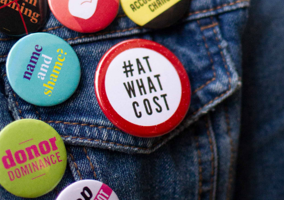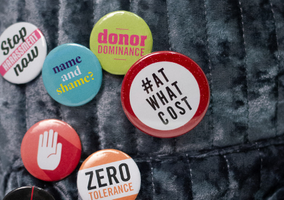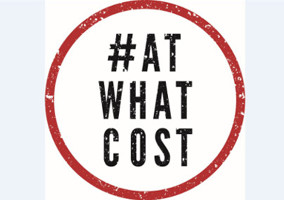The issue of sexual harassment has been pushed firmly into the spotlight over the last year or so with the rise of high-profile campaigns. And it’s long overdue. The extent to which inappropriate behaviour has been normalised in everyday life, from Hollywood to the high street, is a justified cause for concern and one that is now hopefully being addressed at a global level.
In fundraising, there are several factors that make the industry particularly prone to harassment of this nature. These include: the inherent power imbalance between donor and fundraiser; the predominantly female demographic of the workforce at junior levels; and the frequency of opportunity for predatory behaviour during one-to-one meetings, street fundraising, gala events and conferences.
“Where you have a power imbalance that is gendered, there will always be people who will abuse their position and behave in a predatory way,” says Helen Rippon, chief executive officer of Worldwide Cancer Research, which is addressing this issue in its staff training and codes of conduct. “There is a tension between financial benefits and the behaviour of donors. If we are not careful, we can incentivise people to tolerate things that are unacceptable. Furthermore, the sector can operate in quite an informal way and that can lead to very dysfunctional behaviour.”
But to what extent is harassment genuinely prevalent in fundraising?
Hidden in plain sight
When this magazine first published articles on this topic earlier in the year, the response on social media was prolific, suggesting that the problem was pervasive and hidden in plain sight.
Since then, more accounts have come to light. These range from being objectified and told to wear something “more revealing” when meeting a major donor to suggestive comments and unwelcome physical contact from trustees, and sexual assault. Some tales of harassment stretch back decades.
“I don’t know a single female fundraiser who doesn’t have at least one story of experienced sexual harassment, whether by a colleague, donor, supplier or consultant,” says Lizzi Hollis, head of corporate partnerships and engagement at Richard House Children’s Hospice.
This sexual harassment comes in a multitude of forms, she says, from inappropriate comments, sexual assault and microaggressions. And they can happen anywhere.
“Many of the stories I have been told, and my own experience of harassment, have been at events, whether at a staff conference, fundraising gala or at a convention.
“Fundraisers will continue to be at risk in any space where sexism and misogyny persist and where there is not a zero tolerance policy on this behaviour, be it at an event or elsewhere,” she adds.
Research on extent
To put anecdotal evidence in some kind of context, several research projects have looked to quantify more thoroughly the extent of the problem, both within the sector and more broadly in society.
This magazine’s Men and Women Survey in 2016 found that 35 per cent of women fundraisers and 15 per cent of men had experienced some level of sexual harassment while working, predominantly in their place of work or at events.
A 2018 online survey by the North American Association of Fundraising Professionals found that 48 per cent of respondents had personally experienced, witnessed or heard secondhand about incidents of sexual harassment.
One in four women and 7 per cent of men have experienced sexual harassment in the fundraising field.
In 65 per cent of the cases reported in the survey, the perpetrator of the harassment was a donor and, in nearly all cases (96 per cent), the perpetrator was male.
To examine this further in the UK, Plymouth-based fundraising think tank Rogare has launched its Gender Issues In Fundraising research project, which aims to gather together social policy information, and management and business research on this issue.
Strategy director at Ask Direct consultancy and task group leader on the project, Caoileann Appleby, says that the body of work, which will be published over coming months in a series of blogs, aims to critically examine existing research and create readable and actionable resources directly relevant to fundraising.
“We like to think that we must all be good people because we work in the non-for-profit sector, but we are not immune,” says Appleby. “You certainly cannot say that sexual harassment is not an issue for fundraising.”
Leadership failure
Early research conducted in the Rogare project has been looking primarily at interactions with donors and the prevalence of “donor dominance”.
Preliminary results shine light on some worrying trends around team leadership on this issue. Of those interviewed who had experienced inappropriate sexual behaviour from donors, 43 per cent did not report the behaviour. Of those who did, in 27 per cent of cases the charity did not attempt to engage the donor about the behaviour, and the relationship carried on as before with the fundraiser still required to have contact with them. Worse still, around 70 per cent of all those who reported harassment said that they did not feel supported by the charity.
This is a damning statistic and one that helps explain why there is such a disparity between what is being said in the back rooms and corridors and documented official cases.
“As leaders, we have a responsibility to listen and be explicit about what is acceptable and what isn’t,” says Kath Abrahams, director of engagement and fundraising at Diabetes UK. “We cannot assume that everyone would feel comfortable about coming forward and that, just because you have policies in place, they are actually going to do it.”
Taking action
One charity that is taking proactive steps is the British Red Cross.
To get an idea of the extent of the problem, BRC conducted an organisation-wide survey of its fundraising staff around the topics of bullying and harassment, with a particular emphasis on sexual harassment. Around a third of all fundraising staff took the survey, with 80 per cent of the respondents being women.
The results were in line with findings across wider society and private sector surveys, with around 40 per cent of respondents saying they had been subject to some form of inappropriate behaviour, largely from members of the public, donors or prospective donors, ranging from suggestive comments to more serious harassment. Again in line with Rogare’s research, around 50 per cent of those respondents said they had not reported the incident.
“The results were both surprising and confirmatory, reinforcing the point that the work we are undertaking to address this is absolutely critical,” says Paul Amadi, chief supporter officer at BRC. “Our concern was that one of the reasons people weren’t reporting instances of harassment was because they weren’t sure that their managers would know how to respond.”
Having acknowledged this, Amadi says the charity has prioritised the development of toolkits and training for managers, which it hopes will be in place by the autumn. “We need to ensure that managers feel empowered and know what tools are available to support colleagues who are reporting. We also need to ensure that our donors and partners are aware of our expectations in terms of how they interact with us and our codes of conduct.”
Calls to sector bodies
There are mounting calls for sector bodies such as the Institute of Fundraising (IoF) to take a firmer line on reports of sexual behaviour and proactively cultivate a safe environment where people can report their experiences without fear of retribution or judgement.
“The sector and particularly the IoF, as our professional membership body, must respond to this crisis with a zero tolerance policy on sexual harassment and abuse,” says Hollis.
“We need a robust complaints system that protects survivors and takes their allegations seriously. We need a change of attitude away from the obvious and innocuous thought process that makes women who do come forward feel like they are damaging the sector by speaking out, when in fact the fault lies squarely with the abuser.”
In response to such calls, the IoF recently established a task force to look at the issue. Headed by Macmillan’s executive director of fundraising, marketing and communications Claire Rowney, the group’s objectives are “to understand the extent of this problem, look at ways to address it and help fundraisers know their rights about disclosure”.
“There has been a complaints procedure in place at the IoF, but it is not well known and not well used,” says Rowney. “People do not view the IoF as being an organisation that would provide support in this kind of instance. We hope to change that over the coming months. We want to encourage people to come forward with complaints when that is not possible in their workplace. We need to look at how we can become the reviewer of that information, either formally or informally, and take an appropriate course of action.”
Such scrutiny should be extended to all of the IoF’s members, says Rowney. “We need to have a clear sense of what we expect of people who are acting on behalf of the IoF – trainers, speakers or attendees at our events – and talk about what may have or has gone wrong in the past.”
Where do we go from here?
Although the IoF task force has not discussed sanctions as yet, Rowney says that the organisation “would take complaints about members very seriously and take action depending on the wishes of the complainant and the set of criteria under which it would be investigated”.
Hollis believes that, where harassment has been identified, strong action is needed: “There needs to be a process of accountability towards individuals who perpetrate this behaviour and organisations that do not take staff complaints seriously.”
Alternative groups have actively called for the public naming and shaming of those found to have acted inappropriately, either formally or informally. “Personally, I would shy away from this,” says Abrahams. “But I would hope that if anyone feels they want to make a complaint about someone, they should not feel scared or intimidated, regardless of how senior or ‘guru-like’ they might be.
“I also hope that a benefit of a load of noise being created around this issue would be that if you are one of those people who has behaved inappropriately in the past, this would lead you to question your own behaviour and take a long look in the mirror.”
For Amadi at BRC, it is all about driving cultural change within your organisation and the wider sector.
“There is nothing we are doing at BRC that is dependent on the resources we have,” he says. “Most organisations have the tools in place such as code of conduct polices and procedures; they are just not enforcing them or creating an atmosphere where their employees feel safe to report harassment or whistleblow.”
Daniel Guinness, who is director of the Good Lad Initiative, which works with organisations to tackle harassment and toxic workplace cultures, says it is not so much about creating rules as rethinking the professional environment and changing people’s perception of what harassment is.
“You need to think about what you can put in place to change the culture so that people know what harassing behaviours are not acceptable,” Guinness says.
“Key to that is recognising that whether you regard something as being appropriate or not is irrelevant. It is not about the intentions of your actions; it is about the consequences that those actions have had.”
Priya Kantaria talks to HR consultant Lisa Bell on changing work culture
“We’re dealing with people, not processes,” Lisa Bell from HR consultant firm Tell Jane says about sexual harassment in fundraising. “Culture change prevents this behaviour, but if it does occur, then make sure your staff are equipped to deal with it.”
Policy provides a framework, but does not really tackling the issue because people might not follow it. Here is her advice:
- Provide anonymous reporting within your team because of the power elements often involved. Invariably, when you want to report a problem, it needs to go up to someone in power who can do something about it.
- Know the options before encouraging a person to make a formal complaint and embarking on all that involves. The HR process is a grievance procedure. This isn’t pleasant and can be quite daunting. Think about what a good outcome would be for the victim and work backwards from there.
- There is a spectrum of misconduct to consider, from an inappropriate comment to sexual assault. Advice has to be case specific, from working with the individual and helping them to take direct action where appropriate, to being mindful of when this isn’t appropriate, such as in a case of sexual assault.
- Equipping someone with the tools to take direct action is the best way to create long-term sustainable change, but sometimes the right action isn’t clear. Is it good to make an example out of somebody? Perhaps, perhaps not.
- Understand what’s appropriate and what is not and understand what sexual harassment is and what it is not. Often people confuse sexual harassment with sex discrimination, but they are different.
- Understand the risks and the moral obligations, and make changing the culture a priority.
Related articles












